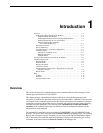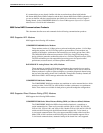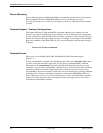
1Introduction
1-36800-A2-GB31-20 January 1997
DATAPHONE II Direct Distance Dialing (DDD) Modems
These modems are capable of full-duplex synchronous or asynchronous data transmission
over the switched telecommunications network at speeds up to 9.6 kbps. The DDD
modems collocated with the 6800 Series NMS have a control channel interface that
allows monitoring by the 6800 Series NMS.
These modems interface with the 6800 Series NMS through the Shared Diagnostic Units
(SDUs). Each SDU oversees up to eight switched network modems and are fully
addressable by NMS.
NMS-Supported Data Service Units (DSUs)
NMS supports the following DSU products:
DATAPHONE II 2600 and 2700 DSUs
These DSUs are designed for multipoint and point-to-point applications. The 2600 Series
DSUs provide digital, full-duplex network data transmission over the DATAPHONE
Digital Service (DDS) and the ACCUNETr Switched 56 Service and do not have
diagnostic capabilities. The 2700 Series DSUs, with a secondary channel capability,
provide digital, full-duplex synchronous data transmission over DDS facilities plus full,
nondisruptive diagnostic capabilities.
COMSPHERE 3600 Series Data Service Units (DSUs)
These DSUs are capable of multispeed operations on the DATAPHONE Digital Service
network or equivalent Digital Data Services network, and can operate as local area
datasets (limited-distance modems). An optional integrated V.32 dial backup module
(DBM) enables backup through the public switched telephone network in case of failure
of the digital connection. DSU interface to the 6800 Series NMS can be via either control
channel connection when directly connected to the 6800 Series NMS, or via diagnostic
channel connection when remotely connected to the 6800 Series NMS.
Paradyne APL Modems and DSUs (via ANALYSIS Gateway)
These modems consist of the MPX, LSI24, and the 3400 Series high-speed DMC protocol APL
modems. These modems perform at speeds ranging from 1.2 kbps to 19.2 kbps. These speeds are
accomplished by using a variety of CCITT Paradyne proprietary and Forward Error Correcting
(FEC) modulation schemes as appropriate for the specific model chosen. The modems can be
controlled by NMS using the cut-through feature and ANALYSIS Gateway, by ANALYSIS NMS,
or independently through the modem’s Diagnostic Control Panel (DCP). The DCP allows the
operator of a modem which is optioned as a control to configure, monitor, and test both the control
and tributary modems in the network.
Naming Conventions
NMS naming conventions enable you to assign a name to a device and to assign a network or
circuit name to a group of logically related devices, such as those devices sharing a common
customer, location, or application. You can then reference or test a group of devices, a network, or
a circuit by entering a single name. Refer to Appendix E of the COMSPHERE 6800 Series
Network Management System User’s/System Administrator’s Guide for a description of the device
naming method accepted by NMS.


















